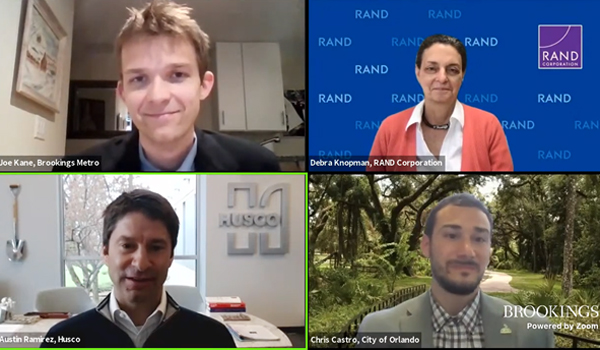Over 1,300 reporters, congressional staffers, White House officials, business leaders, academics, Embassy staff, and other stakeholders, signed up this past Thursday to watch Rebuilding American infrastructure for the 21st century, a virtual event hosted by AEM long-term partner the Brookings Institution.
The event featured keynote remarks by Senator Tom Carper (D-Del.), Chair of the Senate Committee on Environment and Public Works, and Senator Maria Cantwell (D-Wash.), Chair of the Committee on Commerce, Science, and Transportation. Both Senators discussed their vision of what federal legislation needs to achieve to meet today’s infrastructure challenges, while also hinting at the best ways to pay for it. Senator Carper made the case that “some sort of user fee has to be part of the funding mix for this next big investment in our nation’s infrastructure,” while Senator Cantwell stressed the urgent need to “make a once-in-a-generation investment in our infrastructure to make sure we are better able to compete in the global economy.”
A panel of notable experts discussed President Biden’s American Jobs Plan, and the findings of a new report published by Brookings that was made possible with vital funding provided by AEM, between the appearances by both Senators. Austin Ramirez, CEO of Husco and Vice Chair of AEM’s Infrastructure Vision 2050 Task Force, was a featured part of the panel and delivered notable remarks on both the promise of comprehensive legislation addressing our nation’s infrastructure needs, “I am just thrilled we are here having a serious discussion about infrastructure, because for years, if not decades, infrastructure has been a running joke in Washington, and now we have an opportunity to do something serious.” Ramirez lauded the Biden-Harris administration for taking an “expansive and ambitious perspective on infrastructure,” but he also made the point that the American Jobs Plan was “way too big, too partisan, and not funded appropriately.”
Ramirez later provided his thoughts on how to pay for a major investment in our nation’s infrastructure and the proposed funding mechanism in the American Jobs Plan. “The infrastructure plan is not funded appropriately. To put all the infrastructure investment on the back of a corporate tax increase is a bad strategy. I was thrilled to hear Senator Carper talk about Vehicle Miles Travelled (VMT) and user fees, because ultimately, infrastructure needs to be paid for by the people who are using it. There are lots of different ways we can think about user fees, but in my view, this needs to be a significant part of the strategy for how we pay for infrastructure.”
Ramirez also discussed what his top two wish list items are for an infrastructure proposal. “My first point would be that the legislation should be bipartisan. If this bill is bipartisan, it will be a better, more sustainable piece of legislation. There is plenty of bipartisan policy consensus on what this bill needs to include. There's no reason for it to be a single-party bill. So that would be point one. And point two, I would ask our federal policy makers to think about using federal dollars to incentivize and leverage local dollars, not to replace them. I think we too often parachute in with federal dollars instead of thinking about how to use these dollars as a tool to magnify private and local spending.”
In response to the Rebuild With Purpose report release last week, AEM announced a commitment to a set of policy priorities to revitalize the infrastructure systems that move the American economy. Over the last seven years, AEM has advanced its infrastructure policy agenda and driven the national conversation through its Infrastructure Vision 2050 Task Force.
AEM’s Infrastructure Vision 2050 initiative is working to support an optimistic vision for how to build a modern, sustainable, and equitable infrastructure for all Americans. This bold initiative is advancing a forward-looking vision for American infrastructure that will help the United States respond to its biggest challenges in ways that improve the quality of life for all Americans, reinforce America’s global economic standing, and protect the planet. Since 2014, AEM’s Infrastructure Vision 2050 initiative has led the industry’s push to drive the national conversation about the future of U.S. infrastructure. More information about Infrastructure Vision 2050 is available at www.IV2050.org.
A full recording of the event can be viewed here. Contact AEM’s David Ward to learn more about Infrastructure Vision 2050, get involved, or book a speaker.
Some of the answers have been edited for brevity and clarity.
For more AEM news and updates, subscribe to the AEM Industry Advisor.





